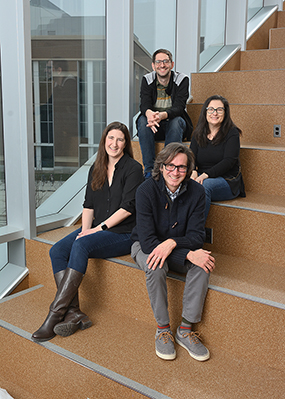$1.9 million NSF grant to amplify math research, community, takes shape at Michigan State
Mathematicians at Michigan State University are using a five-year $1.9 million National Science Foundation training grant to amplify the university’s success in math research by creating communities of undergraduates, graduates, post-graduates and faculty working in topology and related mathematical areas.
The goal: To create environments that nurture mentorship and connections and ultimately open doors to more inclusivity and broader recruitment.

Principal investigators of the NSF RTG project, "Group Algebraic and Geometric Topology
at Michigan State,” are (front row) Teena Gerhardt and Matthew Hedden, and (back row)
Matthew Stoffregen and Efstratia Kalfagianni. Credit: Harley J. Seeley
Principal investigators of the Research Training Group initiative, "Algebraic and Geometric Topology at Michigan State,” are mathematicians Teena Gerhardt, Matthew Hedden, Efstratia Kalfagianni and Matthew Stoffregen.
The topology group at MSU has a long tradition of mentoring graduate students and postdocs.
"The training grant will help us expand and build on this tradition,” said Hedden, a professor in the Department of Mathematics in the MSU College of Natural Science. “We will be incorporating new mentoring practices and enhancing our existing professional development and research opportunities for students and postdocs.”
As in the physical sciences, the world of higher mathematics has a variety of research specialties. In this case, topology is the study of shapes called “topological spaces,” with a primary goal of determining when such shapes are the same or different. The discipline is similar to the perhaps better-known field of geometry, which also studies shapes, but is distinguished from the latter by the rules which govern when two shapes are regarded as the same.
Hedden explained, for example, that to one who studies geometry, a triangle and a circle are quite distinct. In topology, however, a circle and a triangle are often regarded as the same shape, as one could bend a circular loop of wire into a triangle without any dramatic modifications (e.g., cutting the wire). In the world of algebra, another branch of mathematics, equations which define these shapes may be of central interest, and the symmetries of these equations or operations one can perform on them (like addition and multiplication of numbers) play a defining role.
While topologists, geometers, and algebraists are often seen as working in separate mathematical areas, many striking advancements have resulted from communication and interaction between the disciplines. Hedden explained that the goal of strengthening these connections and collaborations underlies many of the grant activities.
The training grant will support 12 graduate students and four postdoctoral researchers who will help facilitate these collaborations between topology and other areas of mathematics, building on MSU’s already strong reputation in the field.
The grant’s activities are also designed to strengthen what Hedden describes as “vertical” connections, formed between researchers at different career stages.
“We’ll bring in strong mathematicians who are early in their career for the postdoctoral positions, and they’ll interact with both the senior faculty and grad students,” Hedden said. “Not only will we as faculty mentor them and learn from them, but the postdocs will learn about mentoring grad students. Similarly, the graduate students and postdocs will play big roles with the undergraduate programs. These interactions strengthen the training of everyone in the group, and ease transitions between career stages. Moreover, new mathematics will result as a byproduct.”
The grant also includes several programs aimed to draw undergraduate students into mathematics, aimed at students who, according to Hedden, “haven’t already gone all-in on mathematics, people with high potential who don’t yet see themselves as mathematicians.”
For instance, the grant will provide support for graduate students to mentor undergraduate freshmen, opening doors to a likely unfamiliar world that has a place for them in graduate school, and as a career. There will also be a “summer directed reading program” – more akin to a fun math camp than a book club – where undergraduate students are introduced to “gateway” topology topics like knot theory, which asks: can this knotted loop of string be untied without cutting it?
“The activities supported by this grant will have a lasting impact on students and faculty,” said Gerhardt, mathematics associate professor. “The grant will strengthen our community of scholars, expanding connections between researchers at different career stages and creating new opportunities for both research and professional development.”
The project also includes senior personnel Robert Bell, Francis Bonahon, Thomas Parker, Tsveta Sendova, Michael Shapiro, and Linhui Shen from the mathematics department, and Elizabeth Munch, who holds joint appointments in the Departments of Mathematics and Computational Mathematics, Science and Engineering.Banner image: The topology group at MSU has a long tradition of mentoring graduate
students and postdocs. This figure depicts a symmetry of 3-dimensional shapes arising
from knotted curves formed by "satellite operations" taken from a paper, "Rank Expanding
Satellites, Whitehead Doubles, and Heegaard Floer Homology," by Irving Dai, Matthew
Hedden, Abhishek Mallick, and Matthew Stroffregen. Mallick was an MSU Ph.D. student
of Hedden's who graduated in 2021.